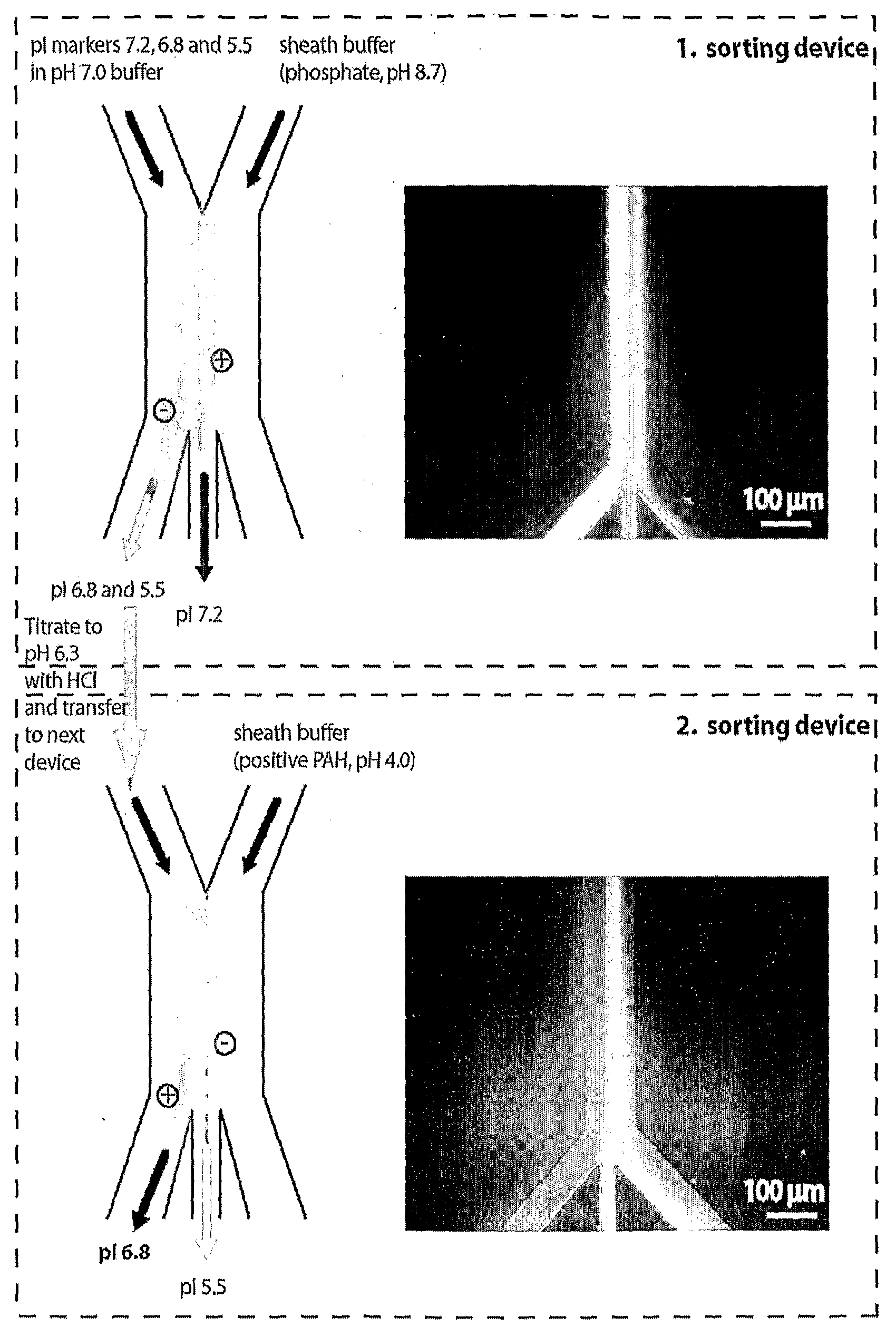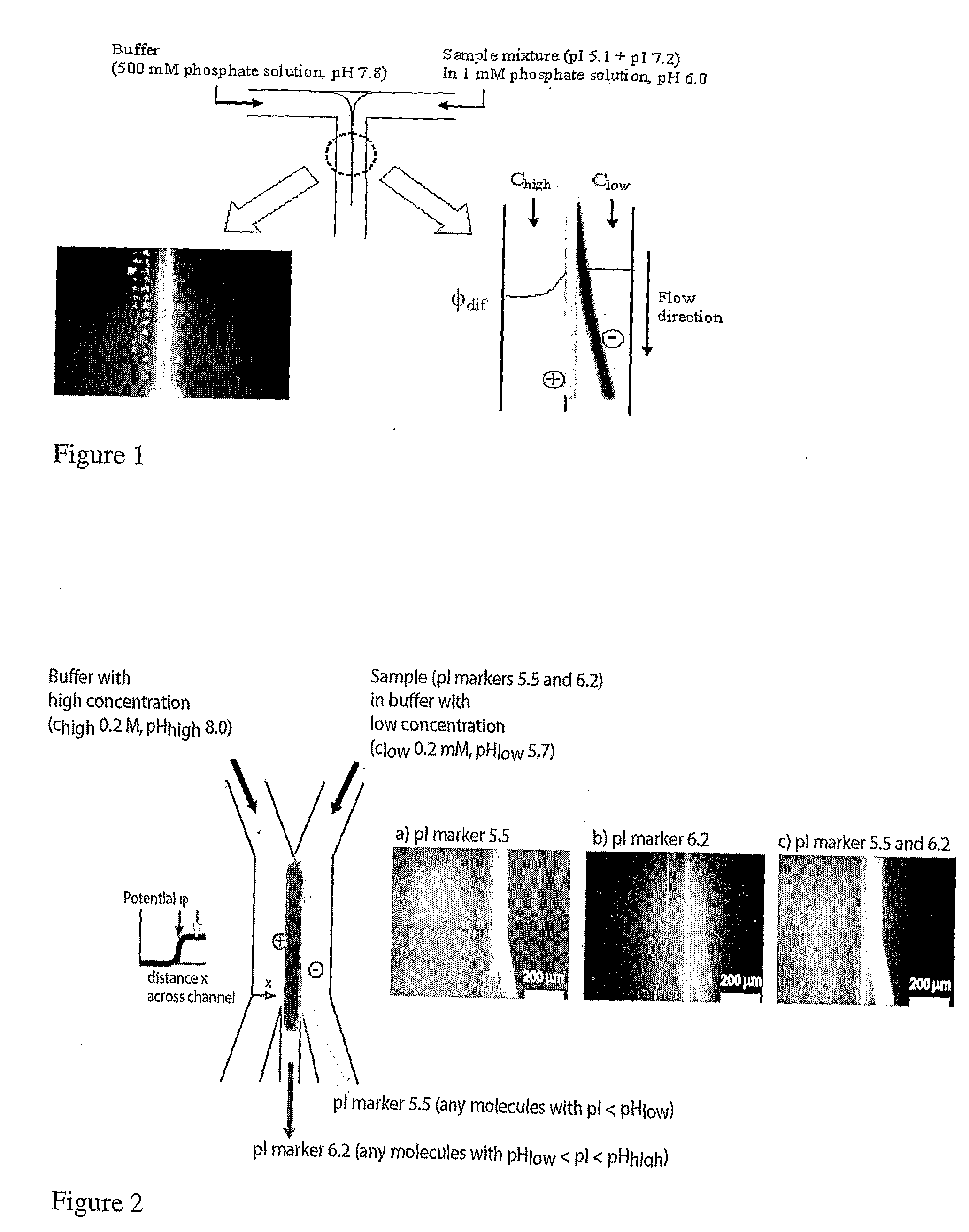Microfluidic pl-based molecular sorting
a molecular sorting and microfluidic technology, applied in the field of pi-based molecular sorting, can solve the problems of limiting the use of proteomics for the identification of lower abundance proteins, lack of sensitivity, and considered too cumbersome to be of any practical utility
- Summary
- Abstract
- Description
- Claims
- Application Information
AI Technical Summary
Problems solved by technology
Method used
Image
Examples
example 1
pI-Based MicroSorting
[0138]At the interface between two fluids with different ionic compositions or concentrations, a diffusion potential is created by the differences in the diffusivity between the ionic species for which a concentration gradient exists. Although small in its absolute value (typically in the mV range), this potential can be sufficient when applied over a small distance in a microfluidic channel with typical sizes between 10˜100 um.
[0139]It was therefore of interest to test whether a diffusion-driven potential may be exploited for charge-based separations of proteins and peptides on a microfluidic chip.
[0140]Since as zwitterions, the protein or peptide molecule can be either positively or negatively charged, depending on the difference between its isoelectric point (pI) value and the pH value of the buffer solution, such molecules may be separated in an electrical field.
[0141]Toward this end, a microfluidic sorting device was constructed, two fluids with different c...
example 2
Other Examples of pI-Based Micro-Sorters
[0147]pI-based biomolecule sorters were developed in two different formats, as shown in FIG. 4. For detecting one or small number of target biomolecules (biomarkers) out of complex mixture of samples, selective collection of biomolecules within a pI range (around the target molecule pI values) becomes important, and this can be achieved by the pI-based microsorter shown in FIG. 5a. In this format, one uses two buffers with different pH values, and the biomolecules with pI values falling in between the two pH values are continuously focused in the centrally within the microchannel and harvested.
[0148]It is of interest at times to scan an entire pH range (3-10) for global analysis of a proteome. For such applications, a pI-based biomolecule microsorter can be used, where two buffers with the same pH value are introduced to the sorter, as shown in FIG. 5b. In this format, the sorter separates proteins or peptides into two groups (one group compri...
example 3
Microsorting Efficiency
[0151]Measuring fluorescence signal intensity across the channel of a microsorter enables the estimation of the efficiency of the sorting process. Fluorescence intensity measurements obtained for a pI marker 6.2 (FIG. 7) shows that it stacks almost completely at the interface with buffer with a higher ionic strength and pH value of 8.0. Fluorescence signal intensity on the right side of the peak remains almost as low as that on the left side.
[0152]Timing of the sorting may also be determined in measuring intensity, where one can observe sorting occurring immediately following mixing of the two buffer solutions in the channel. The height of the intensity peak increases along the channel, indicating more stacking of the molecules downstream.
[0153]The pH difference between the sample buffer and the sheath buffer was found to be essential for increasing sorting efficiency and sorting charged proteins and peptides according to their pI values. Stacking effects at t...
PUM
 Login to View More
Login to View More Abstract
Description
Claims
Application Information
 Login to View More
Login to View More - R&D
- Intellectual Property
- Life Sciences
- Materials
- Tech Scout
- Unparalleled Data Quality
- Higher Quality Content
- 60% Fewer Hallucinations
Browse by: Latest US Patents, China's latest patents, Technical Efficacy Thesaurus, Application Domain, Technology Topic, Popular Technical Reports.
© 2025 PatSnap. All rights reserved.Legal|Privacy policy|Modern Slavery Act Transparency Statement|Sitemap|About US| Contact US: help@patsnap.com



